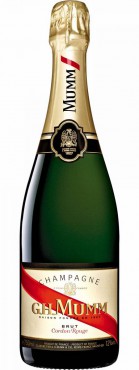
There are a wide variety of sparkling wines made throughout the world. Lets first establish the idea of champagne vs. sparkling wine. Sparkling wine can only be called champagne if it comes from the region of Champagne, which is just outside of Paris.
Further, champagne can only be made using chardonnay, pinot noir and pinot meunier. Made anywhere else, or with different grapes, it is called sparkling wine.
Sparkling wine is made by taking the simple formula for fermentation (sugar plus yeast equals alcohol and CO2), and not allowing the resulting gas to escape. When you ferment wine in a closed or sealed environment, the carbon dioxide (CO2) returns into the wine, only to be released in the form of tiny bubbles after opening.
The story of how this all started is attributed to the monk Dom Perignon (1638-1715), who is noted to have said, “Come quickly, I’m seeing stars.” But in reality it was probably discovered slowly over time by many monks in the Champagne region.

Producers from every other region of the world have begun to make sparkling wine, given the popularity of the bubbly and the rising cost of champagne. In Spain, cava is made in many different styles, but the best examples have small bubbles and balance freshness with creaminess.
The wines that sparkle in Italy — or more specifically the Veneto region of Italy — are called prosecco and have larger bubbles (better for cocktails) and a focus on the fruit. In Austria and Germany, they are called sekt (pronounced zekt). Now you also see great sparkling producers in Argentina, Australia, Tazmania and of course the United States.
Three Hallmarks of a Good Sparkler
Fresh: Bright and alive in your mouth, fruity but not necessarily sweet.
Precise: On the tongue, the wine should feel direct and penetrating. Precision is more about the acid, which is mandatory for good sparkling wines.
Sparkling: Small bubbles are a sign of high-quality wine.
Whether sparkling wine or champagne, the truth is that sparkling wine is gaining in popularity as people realize that it is the most versatile wine for pairing (aka the scrubbing bubbles for the palate) and transitions beautifully from breakfast to dessert and light dishes to fried foods, spicy cuisine or rich sauces. They’re also great as aperitifs and with dishes that have a bit of fruitiness or sweetness.

Some Select Sparkling Wines
Chateau Ste. Michelle Columbia Valley 2009 Luxe ($23)
Blend: 91.4 percent chardonnay, 8.6 percent pinot gris. This bottle is fermented sparkling wine, produced using traditional Méthode Champenoise techniques. It exhibits fruit-forward aromas of lemon-lime and crisp green apple. Plentiful fruit and hints of toasted hazelnut greet the palate and finishes with a crisp acidity. Food pairings: clam chowder, cedar-planked salmon, cracked crab. (Alc. by volume: 11.5 percent)
Michelle, Extra Dry, Columbia Valley, NV, Woodinville, Wash. ($14)
Blend: 63 percent chardonnay, 19 percent pinot noir, 18 percent pinot gris. Style: sparkling wine; light straw color. Aromas and flavors: apples and pears; palate: crisp acids and a persistent column of bubbles; medium body; balanced finish. Great for ringing in the New Year. (Alc. by volume: 11 percent)
G. H. Mumm Winery NV Brut Cordon Rouge Champagne from Champagne, France ($30)
Winemaker’s notes: A long aging provides additional flavors of vanilla, roasted nuts and a hint of toast. A result of the carefully chosen infusion of terroir and reserve wines, the finish is long. Imparting to the finish is lightness from chardonnay, fruitiness from pinot noir and roundness provided by pinot meunier.

Muscat Wines
Muscat grapes are comprised of hundreds of varieties that range in color from white to almost black. They are grown in temperate climates around the world in Italy, France, Greece, Spain, Australia and California. This category of grapes has existed for centuries and is one of the oldest known to mankind.
Muscat wines are noted for their musky, fresh-grape flavors, and range from fine, light whites (sometimes sparkling) to sweet, dark versions (often fortified).
Muscat Blanc à Petits Grains (“white muscat with little berries” ($14) is generally regarded as the best of the muscat grape family. It varies in color from white to pink to dark reddish-brown. It is responsible for the lovely, sweet, fortified Muscat de Beaumes de Venise wines from the southern Rhône.
In Italy, it forms the basis for the sparkling Asti Spumante and Muscat d’Asti wines. (Martini and Rossi, $15). Although also vinified dry, these colored grapes are best known for making the fragrant sweet wines from Italy’s Alto Adige region. Regardless of where muscat grapes are grown or what types of wines they are used to produce, the perfumed, musky, ripe-grape characteristics persist.
Opera Prima, Sparkling Moscato, NV, Daimiel, Spain ($8)
Style: Charmat method; pale-yellow color. Aromas: beautiful rose petal and lychee fruit; silky-sweet flavors; medium body; crisp, refreshing finish. Food pairing: wide range of desserts. Serve well chilled. (Alc. by volume: 7 percent).



























